December 10, 2015
A Conversation with Amy Sacksteder
Fjords recently spoke with contemporary visual artist Amy Sacksteder to discuss her work and practice.
1. You work in a variety of media such as drawing, painting, collage and installation. Do you work on all of this simultaneously?
AS: Not usually. I tend to make installations specifically for shows or projects with a deadline. I often use the pressure of the deadline to push myself to try something new, as was the case with my solo exhibition Will Have Been in Reno in 2012. Typically, I prefer to work on one (2D) series at a time, though sometimes I bounce back and forth between drawing, paper media and painting because they function very differently for me both in my mind and physically.
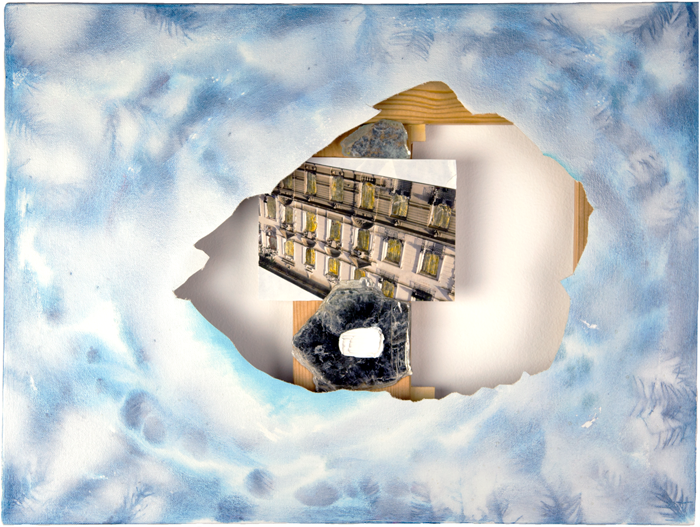
What is Taken and What is Left
Oil on canvas with found mirror fragment, mica, silver leaf, tape on magazine collage
2. What kind of themes and/or narratives do you pursue in your work?
AS: I tend to focus more on themes and less on narrative, with the exception of a body of work that unfolded over 2009-2011, which dealt with the last known moments and words of Amelia Earhart. I was interested in her last words as the closest insight that we as living, conscious beings have into the threshold and inevitable phenomenon of death. I became fixated on physical and visual elements involving her narrative such as the South Pacific island upon which she may have been a castaway (Gardner) and the island for which she was destined when she was lost (Howland). I think aerial and NASA images of those glowing islands surrounded by black water—which in these images become nebulous in terms of scale or substance (are they geodes? amoebas?)—along with my first Iceland residency in 2010, led me to my more current work which depicts and engages the souvenir object as well as various kinds of plant life and foliage. There has been the odd foray into other narratives such as Robert Smithson’s choosing of the site of Spiral Jetty (near Promintory Point) after visiting that site on a southwest road trip my husband and I took in the summer of 2011. That experience resulted in the piece Landblindness.

Landblindness
Gouache, ink, salt, correction tape, and metal leaf on paper
3. How do you start a work: with a concept or with an image, or perhaps both?
AS: It really depends on the work and the time in my life. Occasionally I have these mental images, which feel a bit like worked out puzzles, that come to me at odd moments like sleeping, showering or running. These flashes result in hastily drawn, crude little sketchbook maps for larger pieces. I think as a response to a particularly time-consuming drawing Cumulus, which I completed at the Takt residency in Berlin in 2013, I deliberately decided to work more responsively, with a less mapped-out vision. That is where the series Cairn was born. A friend at the residency taught me an easy way to stretch paper and I wanted to experiment with wet-into-wet paint application, responding to the blooms of liquid acrylic as though they are small worlds. The concept of the cairn gives them their stacked compositions. At that point I had spent two months in Iceland in 2010 and was planning to return again in fall 2013. I knew I wanted to work on these drawings while I was there. Having travelled a lot that year, the concept of the souvenir object and all mementos that remotely function as souvenirs—such as postcards, photographs, even memories—became my general subject of interest. I was also seeing a lot of communication markers on my runs and hikes in Iceland, such as spray painted directives on sidewalks, ambiguous letterforms, tags, and symbols on walls, as well as spray painted rocks used as guideposts. The graphic nature of these artifacts (left by people as forms of communication) contrasted perfectly with the natural items I was drawn to depicting as souvenirs (meant taken by people in order to remember).
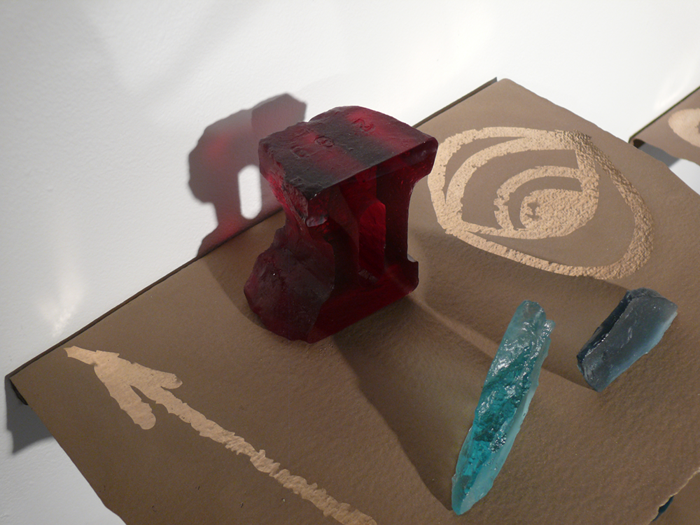
Souvenir(s)
Cast bronze and glass wall installation
4. What is a key element in creating a good composition for your collages?
AS: The collages Generation(s) were born out of my desire to return to the studio shortly after the birth of my son in April 2015. I had (and still have!) a partially started series of oil paintings in my studio, but I don’t work quickly or intuitively with oils. I had printed out images of objects I had photographed with the idea of painting them, but then I started responding to the photos themselves. I began printing them on toned papers such as Fabriano and Rives BFK and the collages just started happening…I enjoy that feeling where the work is driving me and I’m just a set of eyes and hands making it happen. I also like that the process is tidy. The fact that I can pop into the studio for short period and work on my collages is extremely convenient. Speaking specifically to their compositions, I think they are driven by the fact that most elements are depictions of objects that cast a shadow against a ground plane or a background. I like to cut out objects and fill that void with other information that potentially confuses and confounds the perception of the way space functions in them.
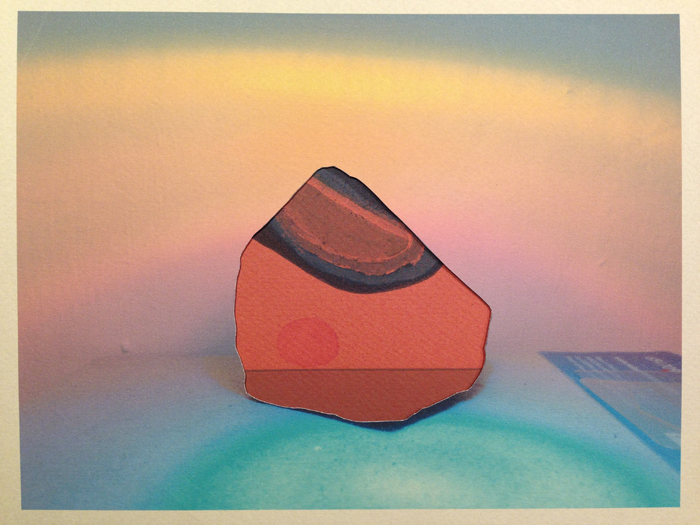
Generation(s) Terminal
Cut and collaged inkjet prints on paper
5. Several of your collages and installations convey an aura of “cosmic geology”. Particularly the works that feature clusters of multicolored stones and minerals that hover in gradient atmospheres. Do you ever look to earth sciences or planetary sciences for inspiration?
AS: I am definitely inspired by the earth sciences, still having and sometimes referencing my childhood rock and mineral collection in my work. My work is often driven by wonder, possibly a return to what caused me to have begun a rock collection in the first place. I think it’s very important for humans to connect to nature, thus our tendency toward creating terraria, beachcombing, preserving plant and insect specimens, picking up up a fallen bird nest or a shed antler in the woods. We’re all from and of nature, and are returning to it at some point after all.
Generally, I do not specifically refer to the planetary sciences, but I like this term “cosmic geology” and I am absolutely fascinated by outer space, meteors, the field of astronomy, etc., so perhaps the influence is unconscious. I do like to listen to science-based podcasts and documentaries while in the studio, and I am a big fan of Neil Degrasse Tyson (Cosmos). I also like other –ologies and –ographies; cartography and meteorology being of particular interest.

Then-and-Then
Gouache, ink and evaporated glacial water on collaged paper
6. What is the most unorthodox material you have ever used in a piece?
AS: I love this question! Materials are really important to me. I am continually communicating to my students the power that a work of art can have if the materials and concept of a work mutually reinforce one another. I like to use resonant materials whenever I can. For example, one piece Then and Then depicts a chunk of ice from a specific lagoon in Iceland. It was important for me to use water from that melted ice to mix with my gouache to paint the piece. However, I was making it at home in my studio in Michigan, so I dispatched a friend who was on a residency in Reykjavik to travel to the same glacial lagoon to collect some of the water. She ended up traveling to see me in the states, and brought the jar of water on the plane with her tucked into a shoe to protect it. I also often use plants as stencils—many times the invasive species (buckthorn, tree of heaven) that were thriving in the otherwise neglected garden when we moved into our new home in 2012. I was working on some projects in Detroit at the time and tended to make use of those same invasive plants that are quickly reclaiming formerly urban property. The idea of invasive species where flora and fauna are concerned is complex and can be a fraught metaphor for human land use, displacement, and ownership.
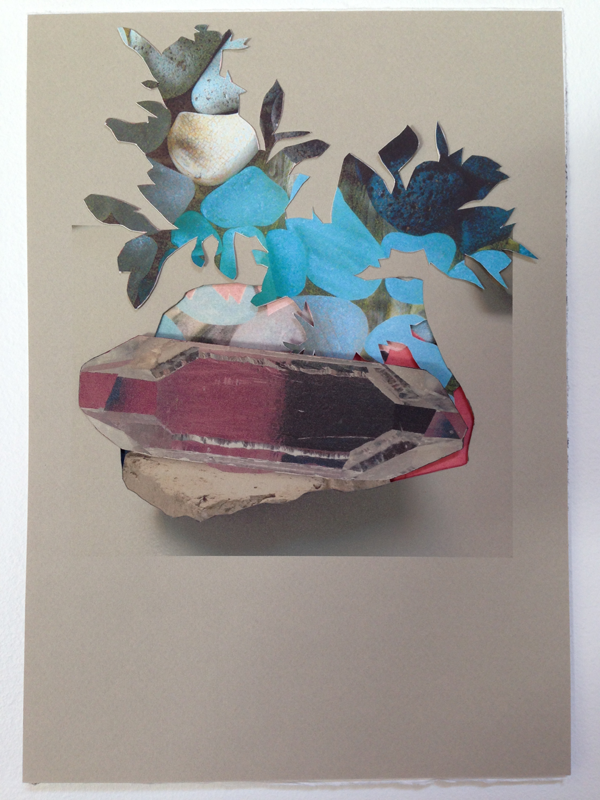
Generation(s)
Sea glass cut and collaged inkjet prints on paper
7. You have been an Associate Professor of Drawing and Painting at Eastern Michigan University since 2011. Has this changed your practice over time?
AS: Of course. I actually started at EMU in 2006 as an Assistant Professor. Inevitably the work I do in the classroom with students and the work I do in my studio are mutually informative: I am an eight-minute walk from school and my art studio is located in my home. For example, the very first few Generation(s) collages began as demos in an upper level drawing class that explored contemporary methods and materials. They started off as experiments in a unit about working with various drawing media into the printed image and spun off into a series. I’ve had students in my studio when I was framing for a show in order to show them how I frame my work. Every so often, I hire students and alumni to assist me in the studio as well.
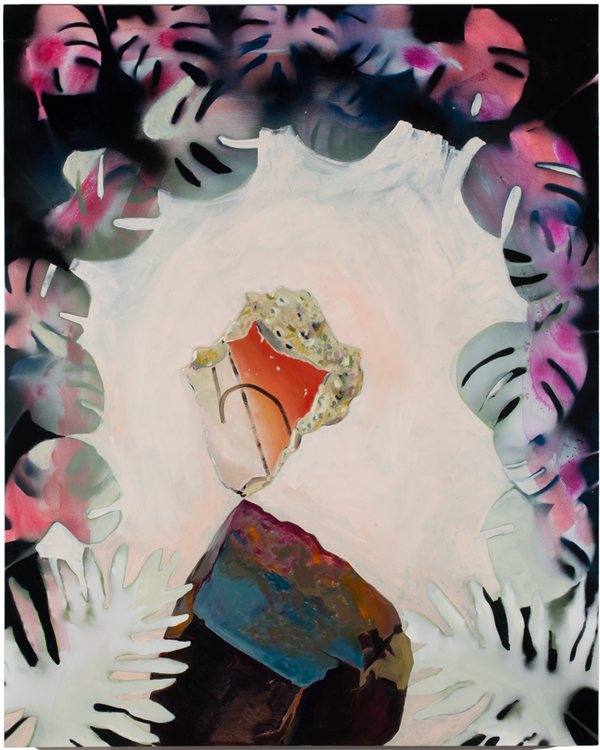
Nichts als die Zeit
Acrylic, oil and lily pollen on canvas
8. Tell us about your recent solo show at Dayton Visual Art Center. Which pieces were on view?
AS: That show was entitled Amy Sacksteder: The Interior. The Interior has a threefold reference: to actual interiors and domestic spaces; to the difficult-to-access, centrally-geographic area of Iceland (or more broadly, other land masses); and the mental and emotional interior of any one person, the psyche. I showed the Cairn series in its entirety (20 pieces), two paintings—What is Taken and What is Left and nichts als die Zeit and a wall installation called Souvenir(s). This installation is comprised of a number of bronze shelves made from casting pieces of watercolor paper. They have some of the graphic artifact images from the Cairn drawings polished into their otherwise matte surfaces. When gallery lights hit these polished areas at the appropriate angle, they’re reflected shimmering up the surface of the wall. Upon these shelves sit small arrangements of glass casts of the souvenir objects. I had the casting for both the bronze and the glass commissioned. EMU alumni Ilana Houten and Jessica Tenbusch did the bronze casting and Toldeo-based glass artist Tim Stover did the glass casting. This was the first time I had outsourced work on this level and I had a couple of grants from EMU, where I teach, to help us realize this project.
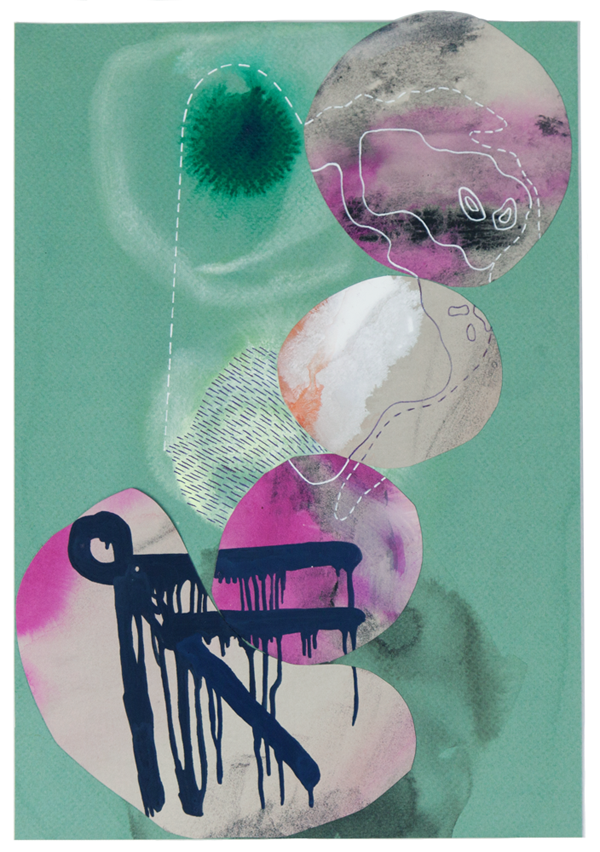
Cairn Collider
Acrylic, gouache, ink, collage on paper
9. Finally, is there a particular body of work that is particularly meaningful to you right now?
AS: I think there are two bodies of work that presently resonate with me. One is the current collage series Generation(s) because it’s underway, so it is always on my mind as I mentally arrange bits and pieces between actual stints in the studio. The other series I keep coming back to is Object Of... which I think means that I have another one up my sleeve that I’d like to work on this winter in my chilly studio (a renovated two-car garage) while hovered over the space heater. Those pieces have a magical quality to them, but I think any pieces I take on in the future will be guided by some spatial qualities that are emanating from the collages.
